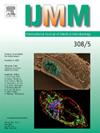放线菌聚集菌a、b和c血清型外膜囊泡的特征及其与人中性粒细胞的相互作用
IF 3.6
3区 医学
Q1 MICROBIOLOGY
引用次数: 0
摘要
放线菌聚集菌(Aa)是一种与牙周炎和全身疾病相关的革兰氏阴性口腔病原体。已知有7种血清型Aa,其中血清型a、b和c在世界范围内最为普遍。有趣的是,血清型a、b和c分离株在毒力上存在差异。这使人们对它们分泌的毒力因子感兴趣。革兰氏阴性菌进化出一种特定的蛋白质分泌机制,基于释放带有蛋白质货物的外膜囊泡(OMVs)。因此,本研究旨在研究OMV蛋白运载量的差异是否可能与Aa血清型a、b或c的不同毒力有关。因此,不同的OMV蛋白质组通过质谱法定义,并与人类中性粒细胞进行感染测定,中性粒细胞代表了对Aa等口腔病原体的主要先天防御。随后,我们将OMV蛋白质组数据与观察到的OMV-中性粒细胞相互作用联系起来。共鉴定出276种omv相关蛋白,包括53种已知的毒力因子。有趣的是,不同血清型Aa分离株的omv表现出相似的蛋白质载货,但相对数量不同。血清型a分离株的omv在携带具有潜在毒力作用的CRISPR蛋白方面表现异常。有趣的是,Aa omv大多包裹在中性粒细胞表面,触发中性粒细胞胞外陷阱(NETs)的形成。相反,篮网获得了Aa个omv。由于观察到的omv -中性粒细胞相互作用将发生在距离产生omv的细菌很远的地方,我们假设它允许细菌逃避中性粒细胞的捕获和消除。本文章由计算机程序翻译,如有差异,请以英文原文为准。
Characterization of outer membrane vesicles of Aggregatibacter actinomycetemcomitans serotypes a, b and c and their interactions with human neutrophils
Aggregatibacter actinomycetemcomitans (Aa) is a Gram-negative oral pathogen associated with periodontitis and systemic diseases. Seven serotypes of Aa are known, with serotypes a, b and c being most prevalent worldwide. Interestingly, serotype a, b and c isolates present differences in virulence. This focuses interest on their secreted virulence factors. Gram-negative bacteria evolved a specific protein secretion mechanism, based on the release of outer membrane vesicles (OMVs) with a protein cargo. The present study was therefore aimed at investigating whether differences in the protein cargo of OMVs could be associated with the differential virulence of Aa serotypes a, b or c. Accordingly, the different OMV proteomes were defined by mass spectrometry and infection assays were performed with human neutrophils that represent the main innate defense against oral pathogens like Aa. Subsequently, we correlated the OMV proteome data with the observed OMV-neutrophil interactions. A total of 276 OMV-associated proteins was identified, including 53 known virulence factors. Interestingly, OMVs from Aa isolates with different serotypes displayed similar protein cargo, but the relative quantities differed. OMVs of serotype a isolates were exceptional in carrying CRISPR proteins with a potential role in virulence. Intriguingly, Aa OMVs mostly coated the neutrophil surface, triggering formation of neutrophil extracellular traps (NETs). Conversely, the NETs captured Aa OMVs. Since the observed OMV-neutrophil interplay will occur at a distance from the OMV-producing bacteria, we postulate that it allows the bacteria to evade capture and elimination by neutrophils.
求助全文
通过发布文献求助,成功后即可免费获取论文全文。
去求助
来源期刊
CiteScore
9.70
自引率
0.00%
发文量
18
审稿时长
45 days
期刊介绍:
Pathogen genome sequencing projects have provided a wealth of data that need to be set in context to pathogenicity and the outcome of infections. In addition, the interplay between a pathogen and its host cell has become increasingly important to understand and interfere with diseases caused by microbial pathogens. IJMM meets these needs by focussing on genome and proteome analyses, studies dealing with the molecular mechanisms of pathogenicity and the evolution of pathogenic agents, the interactions between pathogens and host cells ("cellular microbiology"), and molecular epidemiology. To help the reader keeping up with the rapidly evolving new findings in the field of medical microbiology, IJMM publishes original articles, case studies and topical, state-of-the-art mini-reviews in a well balanced fashion. All articles are strictly peer-reviewed. Important topics are reinforced by 2 special issues per year dedicated to a particular theme. Finally, at irregular intervals, current opinions on recent or future developments in medical microbiology are presented in an editorial section.

 求助内容:
求助内容: 应助结果提醒方式:
应助结果提醒方式:


